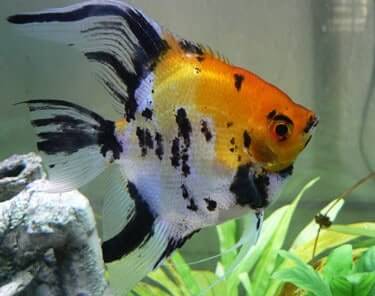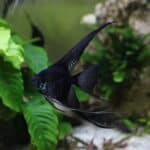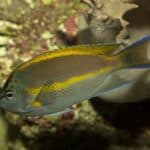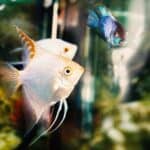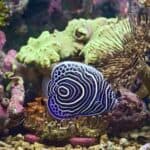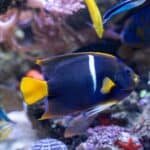Your angelfish have successfully bred and produced spawn. However, the difficult work isn’t over. You must now confirm that your angelfish eggs are fertilized. If they’re not, they should be removed from the tank immediately to avoid infecting other live eggs. The healthy eggs need to be carefully monitored to ensure that they hatch and stay healthy.
If angelfish eggs are fertilized, they will have amber or brownish coloration. They will be mostly translucent, not cloudy or murky. They will be adhered to the spawn site and buoyant if removed. You may even see the angelfish larvae, yolk sac, and an oil globule contained inside the egg. The parents will also have distinct behavior around fertilized eggs, such as guarding habits.
Infertile eggs are white or pale in color and may even grow fuzzy. There are 3 stages to a fertilized angelfish egg. These include the pre-hatching stage, wriggler stage, and free-swimming or fry stage. Even if there are hundreds of eggs present, only a few will reach adulthood.
Fertile vs. Infertile Angelfish Eggs
Angelfish may lay hundreds of eggs at a time, and not all of them will be properly fertilized. This means that, over time, some of them will begin to rot. That may infect other members of the clutch, leading to the entire batch dying.
With that in mind, it’s crucial to spot fertile vs. infertile eggs. Catching them early will allow you to separate the infertile eggs from viable ones and preserve the remaining clutch.
The problem is, angelfish eggs are small. That can make it hard to inspect them for little signs of life. To help, check out the table below. These physical indicators will help you understand which eggs can turn into healthy angelfish and which need to be removed:
| Fertile Eggs | Infertile Eggs | |
| Color | Amber, brownish | White, other light or pale colors |
| Transparency | Translucent | Opaque |
| Adhesiveness | Sticks well to spawn site | May fall off spawn site |
| Buoyancy | High | Low or lacking |
| Inside contents | Angelfish larvae, yolk sac, oil globule | Empty or not visible |
Fertile Angelfish Eggs
There are 2 very important signs that dictate if your angelfish eggs are fertilized. Good eggs will be:
- Amber to brown in color
- Transparent enough to let you see inside the egg
Any characteristics that deviate from this will indicate that the eggs haven’t been fertilized. Even if they have received sperm, the pale or opaque eggs have a very low chance of hatching.
According to the Japanese Journal of Ichthyology, you can also look out for eggs that aren’t buoyant. Buoyancy is important for angelfish eggs because they require aeration to stay alive. If they sink to the bottom of a tank, they are unlikely to have air pass over them. This results in underdeveloped or dying eggs.
The Cambridge University Press found that fertilized eggs must have an oil globule. If you were to look at an egg closely, an oil globule looks like a small, spherical blob inside the egg. There are 2 purposes of the oil globule:
- It serves as a concentrated energy store for the developing egg
- It provides buoyancy for the freshwater fish egg
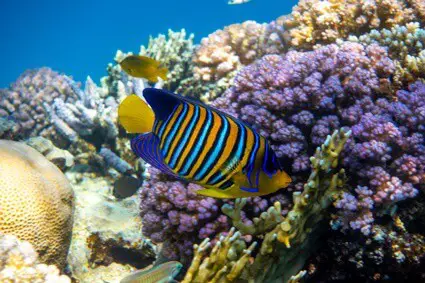
Angelfish Behaviors Indicating Fertile Eggs
Aside from physical attributes, the parents will also show off behaviors that indicate if their eggs are fertilized. Such behaviors include:
- The male actually fertilizing the eggs with genitalia
- The parents have a strong fixation toward the eggs (nipping, skimming over, or fanning)
- The parents antagonizing other fish (fighting, biting, or attacking)
Obviously, watching the male fertilize the eggs will give you a fair hint. This usually occurs right after the female has laid her eggs. At first glance, it may look like the male is just swimming over the eggs.
Upon closer inspection, though, you will see the male’s genitalia brushing over the eggs. The genitalia will look like a small, tubular attachment that is only visible during egg fertilization.
However, this isn’t a guaranteed sign that all the eggs are viable. Even the most experienced angelfish father will miss a few eggs. Additionally, if your male is new to parenthood, he may lack experience and fertilize the eggs improperly.
That makes guarding behavior a more accurate sign that the eggs are fertilized. You may notice your angelfish pair:
- Nipping at the eggs, cleaning away debris
- Skimming over the eggs to protect them
- Antagonizing other fish to scare them away from the eggs
- Fanning their eggs with their fins to aerate them
In the early egg stages, parents are very defensive of their eggs. You will find the angelfish pair:
- Darting at other fish
- Attacking
- Fighting
- Biting to keep outsiders away
Infertile Angelfish Eggs
Despite their small size, you can usually tell if angelfish eggs are infertile with a glance. Infertile eggs will be white or have pale coloration. They will also be opaque and murky, so you can’t see into them.
Eggs with fuzz on them are the worst sign of all. That’s because it’s a consequence of:
- Bacterial or fungal infections
- Not fertilized in the first place by the male
Fungal and bacterial infections happen when the tank is neglected and water maintenance falls by the wayside. You should regularly clean the aquarium and change the filters to minimize how much bacteria is left behind. Fungus will also run rampant if given a chance.
Even in a clean tank, infections may happen if the eggs are laid on porous material. If your angelfish have placed the clutch on wood, for example, these eggs are more vulnerable to fungi and bacteria. This is because porous materials can harbor little microbes, encouraging them to propagate.
Infertile eggs will also fall off their spawn site. Fertile eggs tend to be “stickier” and can hold onto their spawn site more efficiently. If they get dislodged, they will gently float—those that are infertile will sink to the bottom. Even healthy eggs that get trapped at the bottom of a tank are likely to die off soon, since they require aeration to live.
Fertilized Angelfish Egg Stages
If you have successfully identified your angelfish eggs as fertilized, then you can expect your eggs to hatch and develop within 7 days or so.
The following table outlines what you can expect at each stage of development. Depending on your angelfish species and their tank conditions, though, your eggs may hatch sooner or develop faster.
| Time | Identifiers |
| Day 0 | Eggs have been laid |
| Day 1 (24 hours) | You can differentiate which eggs are fertile (amber, brown) and which are not (white, pale) |
| Day 2 (48 hours) | Some eggs may have hatched as wrigglers |
| Day 3 (72 hours) | Most, if not all, eggs have hatched as wrigglers |
| Day 4 (96 hours) – Day 5 (120 hours) | Wrigglers are more developed and some wrigglers may become fry (free swimming) |
| Day 6 (144 hours) – Day 7 (168 hours) | Most, if not all, wrigglers have become free swimming fry |
Pre-Hatching Stage
Remember, fertilized eggs are amber or brown in color and look translucent. You might be able to see movement within them as well.
About 24 hours after your female has laid her eggs, you can tell which fertile and which are not. Male angelfish tend to fertilize their partner’s eggs within hours after they have been laid.
This is why you should give it about a day to see which eggs are viable. It takes time for the angelfish larvae to develop within the egg.
Wriggler Stage
By day 2 or 3, some of your eggs may have hatched into wrigglers, or their pre-free-swimming stage. At this point, they will not really look like angelfish, but more like tiny tadpoles or worms.
While they can move, they are still highly dependent on their parents for transportation. Some wrigglers may even fall off the spawn site. Do not worry if you see the parents bringing the wrigglers into their mouths. This is just how angelfish transport their offspring around, especially if you see them spit the wrigglers out toward the spawn site.
Those that do not fall off their spawn site will be attached to their yolk sac. This yolk sac will be used for essential nutrients over the subsequent days, aiding in their development. Over time (within day 4 or 5), you will notice the yolk sac decreasing in size. This happens as the wrigglers deplete their nutrients. You may or may not be able to see their eyes at this stage.
Free-Swimming or Fry Stage
At this point, your angelfish wrigglers will have broken free from the yolk sac in their egg. They will be larger in size and you can see their eyes much better than before. This occurs between days 6 to 7.
They are now considered to be in the “free-swimming stage.” These hatchlings are also better known as angelfish fry.
Your angelfish fry will begin to swim short distances. Some may or may not need assistance from the angelfish parents for transportation. However, the fry will eventually swim all on their own. It is at this stage that you can start feeding them, since they no longer have their nutritious yolk sac to sustain them.
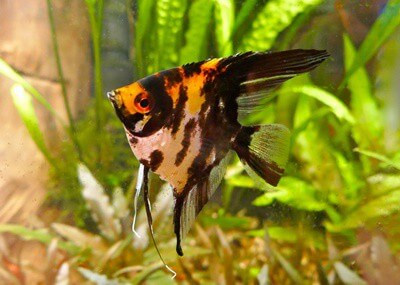
How Long Does it Take for Angelfish Eggs to Hatch?
Given the right conditions, it will take about 60 hours for eggs to hatch after they have been laid. This depends on factors such as:
- Proper aeration
- A hygienic tank
- Appropriate pH levels
- The right water temperature
This will obviously vary from aquarium to aquarium. Some may experience angelfish hatching sooner or even later.
Keeping Your Angelfish Eggs Fertile
You may have successfully determined that your angelfish eggs are fertilized. However, that doesn’t mean they will stay alive. For instance, you may see amber or brownish angelfish eggs one day. Then, you may come back tomorrow and find that those eggs have turned white or opaque.
Both tank hygiene and water maintenance are critical when it comes to keeping your angelfish eggs alive. That’s because eggs are just as delicate as the adults, if not more so. An aquarium that is not diligently cleaned will allow fungi and bacteria to fester.
Worse yet, stress and parenting angelfish do not pair well together. If your adult angelfish become stressed, they may eat their eggs or fry. This stress response is adaptive and may result from:
- Movement outside the tank
- Overcrowding
- Starvation
- Abrupt water and lighting changes
Can Angelfish Lay Eggs Without a Mate?
Angelfish can lay eggs without a mate. Female fish that can lay eggs without a mate are oviparous.
When they are ready to have a spawn, females produce their eggs within their ovaries. These “empty” eggs are then deposited from the urogenital opening to the selected nest site. The male partner then fertilizes these eggs externally.
Female angelfish can lay eggs by themselves. However, they cannot fertilize them alone. They need their male breeding partner to supply the sperm necessary to start the development process. Otherwise, the eggs will not hatch or grow into fry.
Some fish can fertilize eggs internally. However, this does not apply to the angelfish. This fish species requires external fertilization of their eggs.

